Moxibustion Therapy – Meaning, Method Of Doing, Benefits
By Dr Raghuram Y.S. MD (Ay) & Dr Manasa, B.A.M.S
Moxibustion therapy is a type of traditional Chinese medicine (TCM). It is an external treatment. It involves burning moxa, a cone or stick made of ground mugwort leaves on or nearby to the body’s meridian and acupuncture the acu-points. Alternatively it involves baking the acupoints with burning moxa wool. The heat applied stimulates these points and improves flow of energy (qi) in the body. The increased qi in the circulation cures many ailments including pain and digestion problems. Some believe it can treat conditions associated with cold (yang) deficiencies in TCM. It is claimed that it mitigates cold and dampness in the body and can serve to turn breech babies.
Practitioners claim this treatment to be effective in treatment of chronic problems, weakness and also in gerontology. Bian Que (fl. Circa 500 BCE) a famous ancient Chinese doctor, in his work Bian Que Neijing said that moxa could add new energy to the body and could treat both excess and deficiency conditions.
Read – Sweating Treatment – Swedana Types And Methods – Charaka Samhita 14
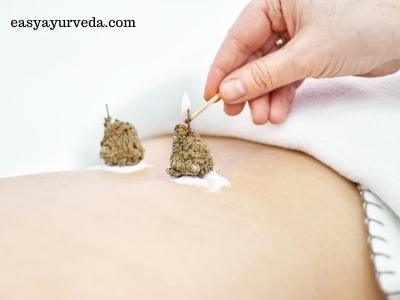
Table of Contents
Benefits
It treats –
- Gastrointestinal issues – like diarrhea, colitis, constipation, irritable bowel syndrome etc
- Pain – related to arthritis, joint pain, muscle pain, chronic pains
- Menstrual cramps
- Asthma
- Eczema
- Fatigue
- Flu and cold
- Urinary incontinence
- Ulcerative colitis
- Cancer
- Stroke rehabilitation
- High blood pressure etc
Concept
Concept of TCM – Moxibustion has dual effect. It is used for tonification and purgation in TCM. It involves dual principles of meridian system and the roles of moxa and fire.
Concept of Modern research works – Modern research opines that relate its mechanism to the thermal and radiation effects and pharmacological actions of moxa and its combustion products.
Experimental results showed that –
- Moxibustion thermal stimulation affects both shallow and deep tissues of the skin
- Warm-heat effects of moxibustion are closely related to the warm receptors and the polymodal receptor
Many ingredients from mugwort leaves and moxa smoke have been identified. They have a variety of biological activities. These were considered to provide comprehensive effects of the therapy.
Read – Kshara Agnikarma Vidhi – Cauterization- Astanga Hridaya Sutrasthana 30
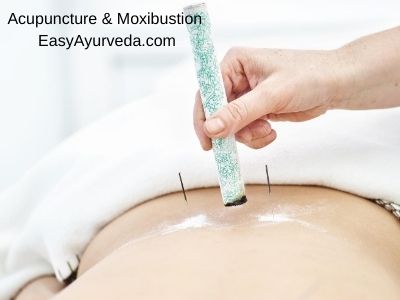
History
It can dredge the meridians and regulate qi-blood. It is used for more than 2,500 years to prevent and cure wide array of disorders. Zuo zhuan is considered to be the earliest literature to mention moxibustion and was written during the pre-Quin dynasty of China. This text documents a disease discussion occurred in 581 B.C.
‘Moxibustion Classic of Eleven Foot-hand Meridians and Prescriptions for Fifty-two Diseases’, a silk book discovered in Mawangdui tomb of the Han dynasty (about 168 B.C.) – has documented the use of moxibustion to treat complex diseases.
The first Western remarks on moxibustion can be found in letters and reports written by Portuguese missionaries in the 16th century Japan. They called it bodao de fogo which means fire button. This term was originally used for round headed Western cautery irons. Hermann Buschoff who published the first Western book in 1674, used the Japanese pronunciation mogusa and spelt it as Moxa. The later authors blended Moxa with the Latin word combustio which means burning.
The name of Artemisia herb i.e. mugwort species used to produce Moxa in China is ‘ai’ or ‘aicao’. In Japan it is called yomogi. The Chinese name for moxibustion is jiu or jiushu. Japanese use the terms kyu and kyujutsu. Koreans call it tteum.
Read – Methods Of Surgical Training Elaborated In Ayurveda
Dimensions of Moxibustion
Moxibustion is used to treat a wide array of diseases. Published papers (from 1954 – 2007) in China shows that it can be used to treat around 364 different kinds of diseases.
Most popular uses are found in treating –
- Mal-position of fetus
- Diarrhea and colitis
- Urinary incontinence and retention
- Dysmenorrhea
- Osteoarthritis, heel pain
- Temporo-mandibular joint disease
- Asthma
- Herpes
- Weakness and fatigue
- Age related problems
Read – Introduction to Unani Medicine
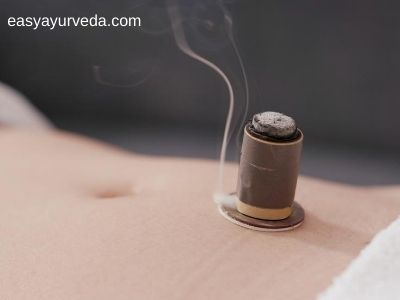
Classification
There are broadly three types of moxibustion, they are –
1. Traditional moxibustion – most commonly used in ancient and contemporary clinics, moxa is used as burning material. Direct and indirect moxibustion are its types. Direct moxibustion is that wherein moxa is directly in contact with skin while operating. In indirect moxibustion the moxa cone is kept at a certain distance from the skin. In this type, air, garlic, aconite, salt and other materials are used as insulating materials.
2. Drug moxibustion – This is also called as nature moxibustion. Here, irritant drugs such as cantharis, garlic and semen sinapis to coat the surface of acupoints and make the local points flushed and blistered to cure diseases.
3. Modern moxibustion – Modern moxibustions such as microwave moxibustion, laser moxibustion and electrothermal moxibustion are used to stimulate traditional moxibustion stimulation factors by physical and chemical methods.
Read – Traditional Vs Proprietary Ayurvedic Medicine – 7 Differences
Materials used
Pu ji fang, Acupuncture cited the Xiao pin fang on 8 kinds of fire used in moxibustion and their impact –
| Sl No | Materials used for moxibustion | Impact |
| 1 | Pine wood fire | Hard to cure |
| 2 | Cedar wood fire | Pus and ulcer |
| 3 | Orange wood fire | Skin hurt |
| 4 | Mulberry wood | Muscle withered |
| 5 | Jujube wood fire | Body emaciated |
| 6 | Bamboo fire | Tendons injured, flabby tendons |
| 7 | Trifoliate orange wood fire | Collapse of veins |
| 8 | Elm wood fire | Bone hurt, excessive bone withered |
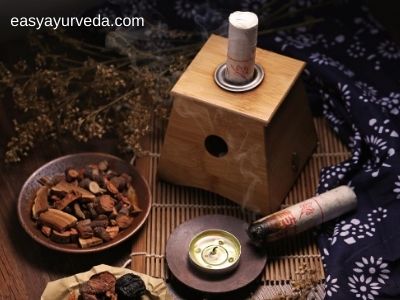
Moxa fire is warm without dry. It can ascend and descend with strong penetration ability into the viscera.
Read – Sushruta’s 8 Types Of Surgical Procedures – Astavidha Shastra Karma
Moxibustion with Moxa
Moxa leaves are slightly bitter and over-spicy when raw. They are slightly spicy and overly bitter when processed. Moxa carries the nature of pure Yang. Raw moxa is warm and become hot after processing. It can take the Tai-Yang fire and get back dying Yang. It can go through three Yin, get rid of all cold and dampness and turn cold into warm after oral consumption. Moxibustion with moxa leaves can get into the channels and cure hundreds of diseases.
The drug properties of raw leaves – They turn warmer after being processed, become moxa wool (processed) which are suitable for moxibustion. The older they are, the better they get.
Read – 4 Types Of Swedana As Per Sushruta And Vagbhata
a. Thermal effects of Moxa
Burning Moxa without flame produces high temperature (548-890 deg C). It will give a warm feel when it is close to the body. The maximum temperature change by indirect moxibustion was about 65 deg C on the skin and 45 deg C in the subcutaneous layer. The actual temperature of indirect moxibustion is affected to a larger extent by the texture, size, and the moisture content of the insulating material. The thermal effects of different moxibustions are not the same. The warm- heat effect of moxibustion has a close relation to the warm receptors (WRs) or and the polymodal receptors (PRs). The antipyretic and thermolytic effects of moxibustion are achieved by stimulating polymodal receptors of acupoints. Effects of moxibustion on the skin can appear as hotness, flushing, pain, blisters and other skin irritations and burns phenomena. Moxibustion can lead to vasoconstriction at the burning point while vasodilatation is caused around the point. It also increases peripheral arterial blood flow and microvascular permeability.
Moxibustion induces heat shock proteins (HSPs) in local tissues. These HSPs may be important factor of the mechanism of action of moxibustion.
b. Radiation effects of Moxa
The burning moxa emits visible light and infrared radiation. This suggests that besides heat effects, nonthermal radiation effect also plays an important role in moxibustion.
Infrared acting on the body will produce thermal and nonthermal effects. Thermal effects are produced under the action of electromagnetic waves, the body molecules absorb energy from IR and convert it into heat and thus promote blood circulation and improve cell and enzyme activities. The non-thermal effect is related to the interaction of EM waves and organism. The near infrared enhance metabolism and thermogenesis of organs they reached. They also energize the metabolism of cells. The energy generated by the photoelectric effect and photochemical process and passed through nerve-humoral system can provide the activation for the pathological cells lacking energy and then further adjust the body’s immune and neurological functions.
Read – Hot Compression Therapy Types, Procedure, Benefits, Precautions
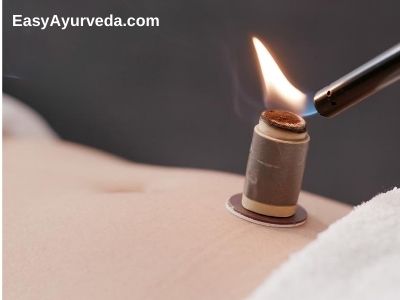
Pharmacological actions of Moxa
Artemisia argyi Levl.et Vant is called Moxa, also known as mugwort. It is a Compositae Artemisia perennial herb. Mugwort leaf can produce moxa wool after drying and grinding. This is a common moxibustion material. More than 60 components have been identified as part of ingredients of moxa. The volatile oils of moxa include 1.8-Cineole, alkenes, camphor, borneol and little aldehydes, ketones, phenols, alkanes and benzene series compounds. Heptatriacontane plays an important role in combustion. Moxa also has tannins, flavonoids, sterols, polysaccharides, trace elements and other ingredients.
The volatile oil of moxa has a variety of biological activities such as expansion of airway smooth muscle, relieving cough, expectorant effect and strong antioxidant activity. The flavonoids and polysaccharides in moxa also bestow strong antioxidant activity.
The smoke of moxa too contains variety of complex useful components. It can be used in air disinfection and as antiviral and antifungal. It has applications in wound infections, vaginal itching, uterine prolapse, anal fistula, common warts etc. The smoke would make effects on the body through breathing.
Read – Warts: Ayurvedic Treatment, Remedies, Prevention Tips
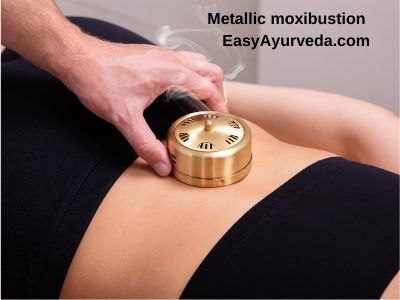
Mode of action
The meridian system probably combines with physical and chemical effects of moxibustion to produce desired effects. When the physical and chemical factors act on the acupoint receptors, the signal enters the central nervous system through the peripheral pathways after being integrated, adjusting the nerve-endocrine-immune network and circulatory system. This regulates the internal environment of the body. This helps in preventing and curing many diseases. Therefore moxibustion is not a simple stimulus. The meridian and acupoint system of the body is the key for efficacy of moxibustion.
Read – Marma Therapy Basics, Text Books, Spiritual Healing, Treatment Planning
Medical Research
Hara Shimetaro, a Japanese physician wrote the first modern scientific publication. He had conducted intensive research about the hematological effects of moxibustion in 1927. His last publication appeared in 1981.
A Cochrane Review found limited evidence for the use of moxibustion in correcting the breech presentation of the babies and called for experimental trials. Side effects included nausea, throat irritation and abdominal pain from contractions. Moxibustion has also been studied for the treatment of pain, cancer, stroke, ulcerative colitis, constipation and hypertension. Systematic reviews have found that these studies are of low quality and positive findings could be due to publication bias.
Read – Hypertension Causes, Types, Symptoms, Ayurvedic Treatment
Ayurveda connection
Like many therapies practiced worldwide, principles of moxibustion too seem to resemble and have been influenced by Ayurveda therapies. Moxibustion involves on providing heat. Therefore it is a modulation which works on the basis of agnikarma explained in Ayurveda.
Moxibustion is done on the acupoints, which match with the marma points. Therefore it correlates with heat therapies done as a part of marma therapy.
Moxibustion is said to balance chi / qi. Chi energy is the same as Prana explained in Ayurveda. Marmas are depots of prana and marma therapy is done to balance Prana.
Read – Importance Of Marma: Need for study
Moxibustion realigns the meridians in the body restoring energy and life principle. The siras and dhamanis are compared to the acupuncture meridians explained by TCM. Marma therapy or marma puncture (Ayurveda acupuncture) balances the flow of prana in the siras, dhamanis and nadis in the body.
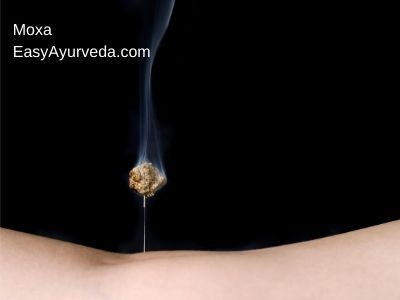
Click to Consult Dr Raghuram Y.S. MD (Ayu) – Skype
References
https://www.ncbi.nlm.nih.gov/pmc/articles/PMC3789413/
https://en.wikipedia.org/wiki/Moxibustion









